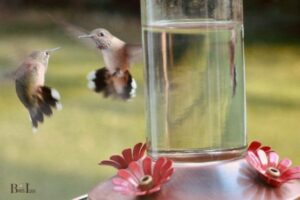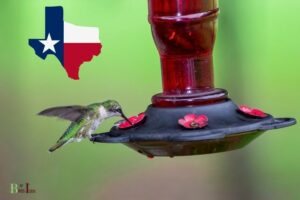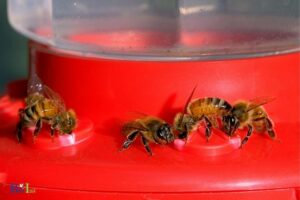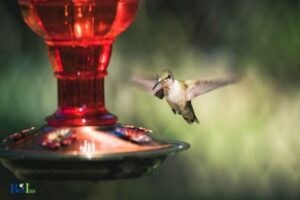How to Clean Perky Pet Hummingbird Feeder: Scrub!
To clean a Perky Pet hummingbird feeder, follow these steps: disassemble the feeder, soak the parts in a warm soapy water solution, scrub with a soft brush, rinse thoroughly, and air dry before reassembling and refilling.
Perky Pet hummingbird feeders are popular choices for attracting and feeding hummingbirds in your garden.
Keeping the feeder clean is crucial to prevent mold, bacteria, and fermentation, which can be harmful to hummingbirds. Regular cleaning is essential for maintaining a healthy feeding environment.
Regular cleaning of your Perky Pet hummingbird feeder is essential for the health and safety of the hummingbirds that visit your garden.
By following these steps, you can ensure that your feeder is clean and free of harmful bacteria, mold, and fermentation.
Additionally, consider cleaning your feeder at least once a week or more frequently during hot weather to maintain a hygienic environment for the birds. Do not forget to replace the nectar regularly, as well, to keep it fresh and appealing to your feathered visitors.
10 Steps: How to Clean Perky Pet Hummingbird Feeder
| Step | Cleaning Process |
| 1 | Disconnect and disassemble the hummingbird feeder |
| 2 | Empty the feeder and discard any remaining nectar |
| 3 | Prepare a warm soapy water solution with mild dish soap |
| 4 | Soak the feeder parts in the warm soapy water |
| 5 | Use a soft bristle brush to clean the feeder parts, including small brushes for the feeding ports |
| 6 | Rinse the feeder parts thoroughly with clean warm water |
| 7 | Allow the feeder parts to air dry completely to prevent mold growth |
| 8 | Reassemble the hummingbird feeder |
| 9 | Refill the feeder with fresh nectar |
| 10 | Rehang the feeder and enjoy watching the hummingbirds |
Key Takeaway
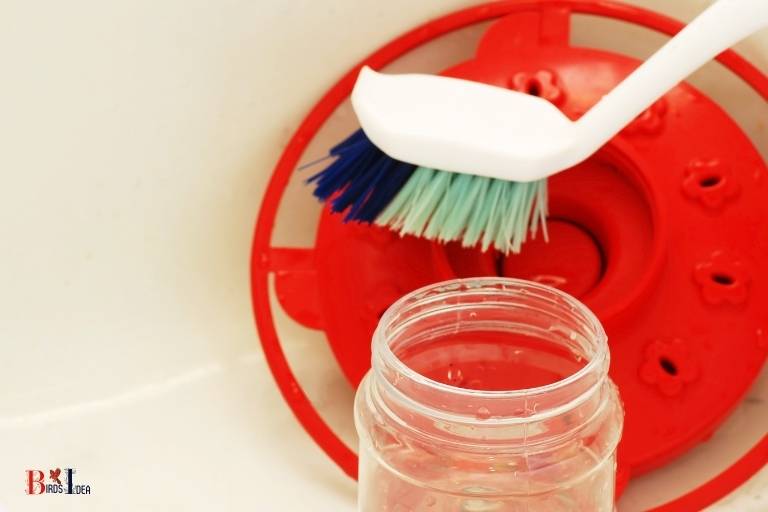
Five Facts About: Clean Perky Pet Hummingbird Feeder
Cleaning Your Perky Pet Hummingbird Feeder
Precautions To Take Before Cleaning
Cleaning your perky pet hummingbird feeder is essential to ensure the health and safety of the hummingbirds that visit your yard.
Before cleaning, make sure to take the following precautions:
- Wear gloves and eye protection to avoid getting in contact with harmful bacteria or mold.
- Choose a well-ventilated area to avoid inhaling any harmful fumes.
- Make sure the feeder is completely empty before starting the cleaning process.
- Remove the feeder from direct sunlight to avoid any damage or discoloration.
Necessary Cleaning Supplies
To clean your perky pet hummingbird feeder, you will need the following supplies:
- Hot water
- Mild soap or detergent
- Cleaning brush or toothbrush
- White vinegar
- Paper towels or lint-free cloth
How To Disassemble The Feeder
The next step is to disassemble the feeder.
Follow these steps to disassemble your perky pet hummingbird feeder:
- Gently remove the feeder from its hanging position.
- Carefully take apart the different parts of the feeder – the base, the bottle, and the feeding ports.
- If there is any dried nectar around the feeding ports, use a toothpick to clean it.
Step-By-Step Cleaning Instructions
Follow these step-by-step cleaning instructions to effectively clean your perky pet hummingbird feeder:
- Soak all the parts of the feeder in hot soapy water for about 15-20 minutes. This will help in breaking down any sticky or dried nectar.
- After soaking, use a cleaning brush or toothbrush with bristles to scrub all the parts of the feeder.
- Once the feeder is scrubbed with soap, rinse it off thoroughly under cold running water.
- Next, fill a container with a solution of 1 part white vinegar to 4 parts water.
- Place all the parts of the feeder in the vinegar solution and let them soak for about 15-20 minutes. This will disinfect the feeder and help remove any mold or bacteria.
- After soaking, rinse all the parts thoroughly under clean, running water to remove any remaining vinegar solution.
- Use a paper towel or lint-free cloth to dry all the feeder parts. Ensure that there is no moisture left as this can cause mold and bacteria to grow.
- Finally, reassemble the feeder using care and attention.
Cleaning Frequency And Schedule
It is recommended to clean your perky pet hummingbird feeder at least once every week. During hotter months, you may need to clean it more frequently.
You should also make sure to clean the feeder thoroughly before refilling it with fresh nectar.
By following these cleaning instructions, you can enjoy the beautiful sight of hummingbirds every day. Remember, a clean feeder is not only safe for the hummingbirds, but also ensures their frequent visit to your yard.
Troubleshooting Common Cleaning Problems
Perky pet hummingbird feeders are an excellent way to attract these tiny, winged wonders to your garden. However, like every other garden accessory, they require proper maintenance for optimal performance.
Proper cleaning of the hummingbird feeder is essential to keep them in good condition and enable hummingbirds to feed without any issue.
In this section, we’ll show you how to troubleshoot common cleaning problems that affect perky pet hummingbird feeders.
Mold And Mildew Growth
Mold and mildew growth in a hummingbird feeder is a common problem that affects the performance of the feeder and poses a health risk to hummingbirds.
To clean mold and mildew from your feeder:
- Disassemble the feeder and remove any remaining nectar.
- Wash all parts of the feeder with warm water and a mild detergent.
- Use a bottle brush or pipe cleaner to clean any hard-to-reach parts.
- Rinse thoroughly with clean, hot water.
- Soak the feeder in a solution of one part white vinegar to four parts hot water for an hour.
- Rinse again with clean water and air dry the feeder before reassembling.
Clogged Bee Guards And Ports
Bee guards and ports can become clogged with debris or dirt, making it difficult for hummingbirds to feed.
This can be remedied by:
- Disassemble the feeder and remove any remaining nectar.
- Use a bottle brush or pipe cleaner to clean the bee guards and ports.
- Rinse thoroughly with clean hot water.
- Soak the feeder in a solution of one part white vinegar to four parts hot water for an hour.
- Rinse the feeder thoroughly with clean, hot water and air dry before reassembling.
Leaking Or Dripping Feeder
A leaking or dripping feeder can be a headache, not just for you, but for hummingbirds too.
The following steps can help solve this problem:
- Disassemble the feeder and remove any remaining nectar.
- Inspect the feeder for cracks, splits or other apparent damage. Replace damaged parts.
- Tighten all connections, including the bottle and base.
- Ensure that the feeder is level and that the lid seals correctly.
- Fill the feeder halfway and check for leaks.
- If you notice any leaks, disassemble the feeder and check for damage to any of the parts. Replace any damaged parts before reassembling the feeder.
Damaged Or Missing Parts
Hummingbird feeders are not indestructible, and it is common for some parts to get damaged or go missing. Damaged or missing parts can affect the feeder’s performance and even lead to spillage that may not be good for hummingbirds.
If this happens:
- Disassemble the feeder and remove any remaining nectar.
- Check the feeder for any damaged or missing parts.
- Charge the missing parts or replace any damaged parts before reassembling the feeder.
- Ensure that the feeder is cleaned according to the manufacturer’s instructions before refilling the feeder with nectar.
By following these steps to troubleshoot common cleaning problems with your perky pet hummingbird feeder, you can take proper care of these beautiful garden visitors and keep them coming back for more.
Tips For Proper Perky Pet Hummingbird Feeder Maintenance
Perky pet hummingbird feeder is a popular bird feeder that can attract a large number of hummingbirds to your backyard. However, to maintain the feeder’s performance and longevity, it requires regular cleaning and proper maintenance.
We will discuss some tips for proper perky pet hummingbird feeder maintenance.
Storing The Feeder During The Off-Season
Storing the feeder properly during the off-season is crucial to its longevity.
Here are some key points to keep in mind:
- Clean the feeder thoroughly and let it dry completely before storing it.
- Store the feeder in a cool, dry place away from direct sunlight and potential damage from rodents or other pests.
- Consider disassembling the feeder for better storage.
Inspection And Repair
Regular inspection and repair can help catch any issues with the feeder before they become major problems.
Some key points to keep in mind include:
- Check the feeder for cracks, leaks, or other damage regularly.
- Regularly inspect the feeder’s parts to make sure they are clean and functioning correctly.
- Repair any issues promptly.
Replacement Parts And Accessories
Replacing parts as needed can keep your feeder functioning correctly for years.
Some key points to keep in mind include:
- Only use perky pet replacement parts and accessories to ensure proper fit and function.
- Replace the hummingbird feeding ports regularly to prevent clogs and build-up.
Upgrading To A Larger Feeder
If you find that your feeder is attracting too many hummingbirds to keep up with, or you want to upgrade to a larger size, here are some key points to keep in mind.
- Hummingbirds are territorial, so placing multiple feeders around your yard can be beneficial.
- Only upgrade to a feeder size you can maintain properly.
The maintenance of a perky pet hummingbird feeder is crucial to its performance and longevity. By following these tips, you can ensure that your feeder continues to attract a large number of hummingbirds to your yard for years to come.
FAQ On How To Clean Perky Pet Hummingbird Feeder
How Often Should I Clean My Perky Pet Hummingbird Feeder?
What Is The Best Way To Clean A Perky Pet Hummingbird Feeder?
Can I Put My Perky Pet Hummingbird Feeder In The Dishwasher?
What Should I Do If I Notice Mold In My Perky Pet Hummingbird Feeder?
Conclusion
Keeping your hummingbird feeder clean is crucial to attract these small, beautiful birds to your yard. The perky pet hummingbird feeder offers a perfect solution to keep them coming back season after season.
With easy cleaning steps, you can maintain the cleanliness of your feeder and ensure the health of your feathered friends.
Remember to clean the feeder at least once a week and replace the nectar every few days to prevent bacteria growth. By following the simple tips discussed in this post, you can enjoy watching and caring for the hummingbirds in your area.
So, clean your perky pet hummingbird feeder today and get ready for an amazing sight of these delightful creatures.


